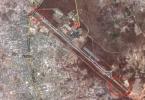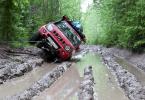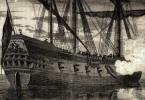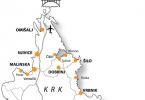King Fahd airport area Saudi Arabia- 780 km². It's 7 times more area Paris - 80 quarters of the French capital fit on 105 km². And 25 km² more than the area of Hamburg (755 km²).
I’ll lose weight by the summer: what to eat at the airport if you follow your figure
February 21, 2020Let's explain for the news: two Italian airports will close in the fall
February 20, 2020I have a transfer in Bergamo: what can be done in one evening
February 20, 2020Let's explain for the news: Sheremetyevo Airport wants to get better
February 19, 2020Closer nowhere: how to get to Jerusalem from neighboring airports
February 18, 2020How to choose the perfect hostel: how they differ and how much they cost
Airports can be compared with cities not only in terms of area. In many ways, the modern air port is organized like a city. There, too, there is an administration, a budget, services that monitor security and order. Let's consider the airport device in a little more detail.

What determines the structure of the airport
From his size. Most of us mean by airport huge complex with hangars, terminals, command and control towers and runways with a 24/7 operating mode. But not all airports meet these standards.
small airports
An airport is also called a short strip of asphalt among grass and dirt, which is used no more than two or three hours a day. These runways often only serve one or two pilots. Such airports may not have any structures other than a runway.
Regional airports
They organize flights within one country, without international flights. Often regional airports serve not only civil aviation but also military.
In regional airports, the infrastructure is more developed. It includes hangars, radio towers, pilot training facilities, weather observation systems. Such facilities sometimes have lounges for pilots, trading platforms, conference rooms, fuel storage.
The full list of objects depends on the traffic and destination of the airport.
The hangars of regional airports usually accommodate aircraft with a capacity of up to 200 people.
International airports
Organize regional and international flights. The infrastructure of international airports is complemented by duty-free shops, service stations, transport system inside terminals, customs control zones.
The runways and hangars of such airports serve aircraft of various sizes. From private - less than 50 people on board, to Airbus A380 - 853 passengers.

Runway strip
Regional airports may have only one runway. In international - from two to seven. The length of the runway depends on the weight of the aircraft. For example, a Boeing 747 or Airbus A380 requires a 3300 m runway to take off. And for takeoff aircraft with a capacity of up to 20 passengers, 914 m is enough.
Stripes can be:
- Solitary. Engineers plan the location of the runway, taking into account the prevailing wind direction.
- Parallel. The distance between two runways depends on the size and number of aircraft using the aerodrome, ranging from 762 m to 1,310 m on average.
- V-shaped. The two runways converge but do not intersect. This arrangement gives air traffic controllers the flexibility to maneuver aircraft on the runway. For example, in light wind conditions, the controller will use both runways. But if the wind picks up in one direction, controllers will use the runway that allows aircraft to take off into the wind.
- Crossed. Crossing runways are common at airports where the prevailing winds vary throughout the year. The intersection point may be in the middle of each runway, in the threshold area where aircraft land, or at the end of the runway.
Taxiways
In addition to the runways, the airport is equipped with taxiways. They connect all the buildings of the airport: terminals, hangars, parking lots, service stations. They are used to move aircraft to the runway or to the parking lot.
Light signaling system
All international airports have the same lighting scheme. With signal lights, pilots can distinguish between runways and highways at night or in low visibility conditions. Beacons that flash green and white indicate a civilian airport. Green lights mark the threshold or start of the runway. Red lights signal the end of the lane. White or yellow lights define the edges of the runway. Blue lights distinguish taxiways from runways.
How the airport works: terminals
The terminals are located representative offices of airlines and services that are responsible for organizing passenger traffic, security, baggage, border, immigration and customs control. There are also restaurants and shops here.
Number of terminals and total area terminal area depend on airport traffic.
The terminal complex at Hartsfield-Jackson Airport in Atlanta, USA occupies 230,000 m². It includes internal and international terminals, 207 passenger pick-up/drop-off gates, seven conference rooms, 90 shops and 56 service points where passengers receive the necessary services - from polishing shoes to connecting to the Internet.
Usually airlines rent gates at the airport. But sometimes they build separate terminals. Such as, Emirates airline at Dubai International Airport. In addition to lounges and aircraft gates, Emirates Terminal offers 11,000 m2 retail space, three spas, two Zen gardens.
In-flight catering
Food for aircraft passengers is prepared outside the airport. It is delivered by truck and loaded on board. Daily at one major airport caterers deliver thousands of meals. For example, three catering providers provide 158,000 meals to Hong Kong Airport every day.
Fuel supply system
During a flight from London Heathrow to Malaysian Kuala Lumpur Jumbo Jet consumes about 127,000 liters of fuel. That's why busy international airports sell millions of fuel every day. Some airports use tanker trucks to transport fuel from storage to aircraft. In others, fuel is pumped through underground pipes directly to the terminals.
Safety system
Passengers of domestic flights go through passport control and security control. Passengers on international flights go through customs, security and passport control.
Airports are looking for prohibited items using combinations software and screening technologies - computed tomography, x-ray machines and explosive trace detection systems. If necessary, passengers are subjected to personal searches or full body scans.
Major airports complement the security system with fire services and ambulance stations.

How is ground transportation at the airport
System land transport ensures the arrival of passengers at the airport and transportation from the air port to the city.
Typically, a ground transportation system includes:
- Roads to and from the airport.
- Car parking.
- Vehicle rental services.
- Flights transporting passengers to local hotels and to car parks.
- Public transport - municipal buses and metro.
Large airports are equipped with an internal transfer system. It includes travelators, mini cars, automatic trains or buses.
The internal transfer system helps passengers get from one terminal to another or to the terminal gate faster.
Budget
Airports are huge enterprises. Denver Airport in the US costs about $5 billion. Its maintenance costs are $160 million a year. At the same time, the state's annual income from the airport is $22.3 billion.
Airports, as a rule, own all facilities on their territory. They rent them out to airlines, retailers, service providers. Fees and taxes on air tickets and services - fuel, parking - occupy several more income items of air ports. Most airports are self-sustaining enterprises.
Staff
About 90 percent of airport employees work for private companies: airlines, contractors, tenants. The remaining 10 percent work for the airport: administrators, maintenance personnel, security service.
| Whether or not this publication is taken into account in the RSCI. Some categories of publications (for example, articles in abstract, popular science, informational journals) can be posted on the website platform, but are not counted in the RSCI. Also, articles in journals and collections excluded from the RSCI for violation of scientific and publishing ethics are not taken into account. "> Included in the RSCI ®: yes | The number of citations of this publication from publications included in the RSCI. The publication itself may not be included in the RSCI. For collections of articles and books indexed in the RSCI at the level of individual chapters, the total number of citations of all articles (chapters) and the collection (book) as a whole is indicated. |
| Whether or not this publication is included in the core of the RSCI. The RSCI core includes all articles published in journals indexed in the Web of Science Core Collection, Scopus or Russian Science Citation Index (RSCI) databases."> Included in the RSCI ® core: No | The number of citations of this publication from publications included in the RSCI core. The publication itself may not be included in the core of the RSCI. For collections of articles and books indexed in the RSCI at the level of individual chapters, the total number of citations of all articles (chapters) and the collection (book) as a whole is indicated. |
| The citation rate, normalized by journal, is calculated by dividing the number of citations received by a given article by the average number of citations received by articles of the same type in the same journal published in the same year. Shows how much the level of this article is higher or lower than the average level of articles of the journal in which it is published. Calculated if the journal has a complete set of issues for a given year in the RSCI. For articles of the current year, the indicator is not calculated."> Normal citation for the journal: | Five-year impact factor of the journal in which the article was published for 2018. "> Impact factor of the journal in the RSCI: 0.117 |
| The citation rate, normalized by subject area, is calculated by dividing the number of citations received by a given publication by the average number of citations received by publications of the same type in the same subject area published in the same year. Shows how much the level of this publication is above or below the average level of other publications in the same field of science. For publications of the current year, the indicator is not calculated."> Normal citation in the direction: 0 |

























